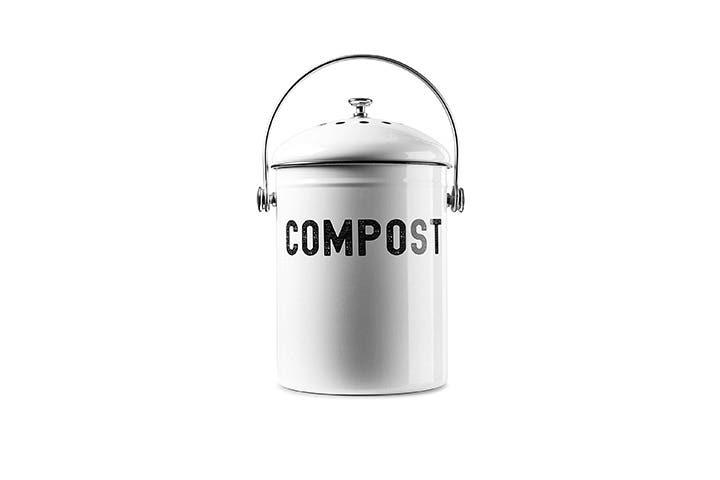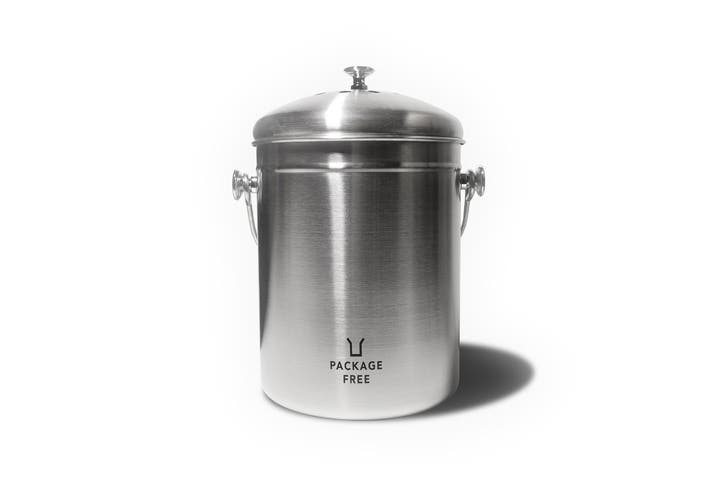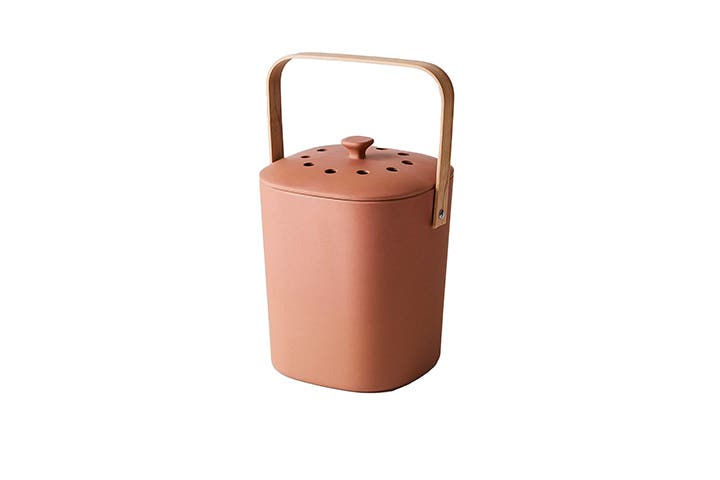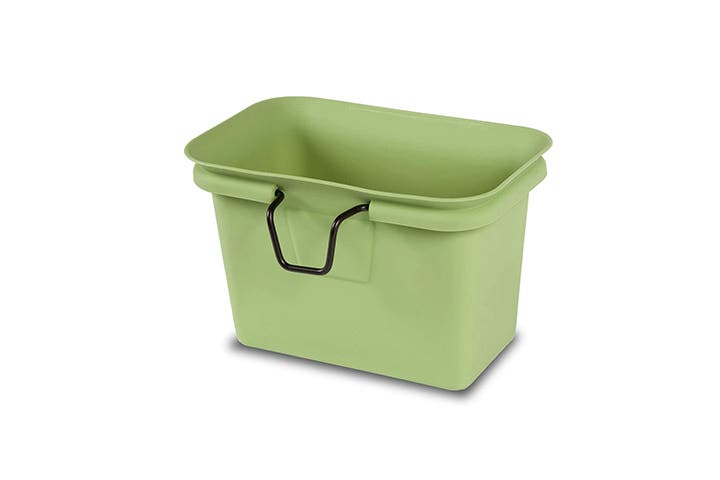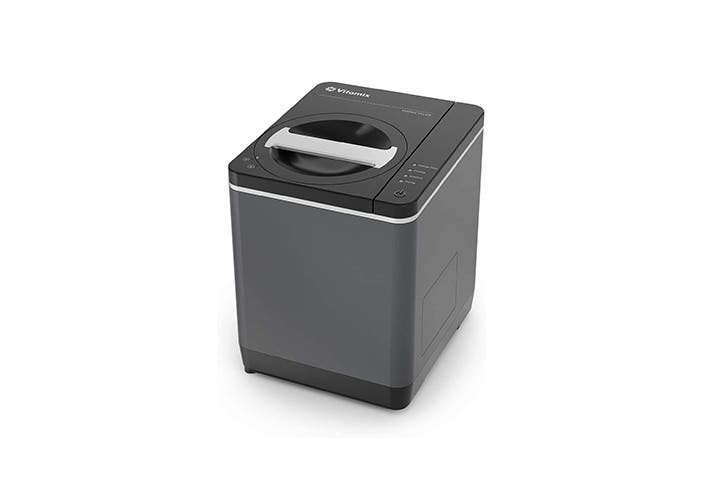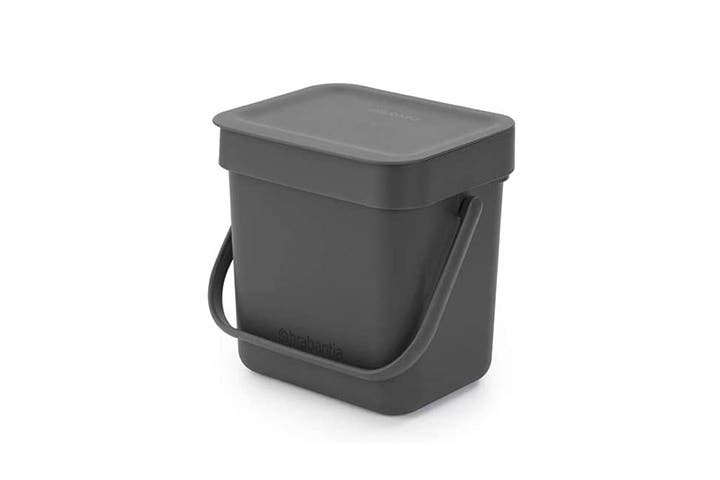Chefs and Sustainability Experts Share the 7 Best Compost Bins to Reduce Food Waste
Including a makeshift option that doesn’t cost a cent.
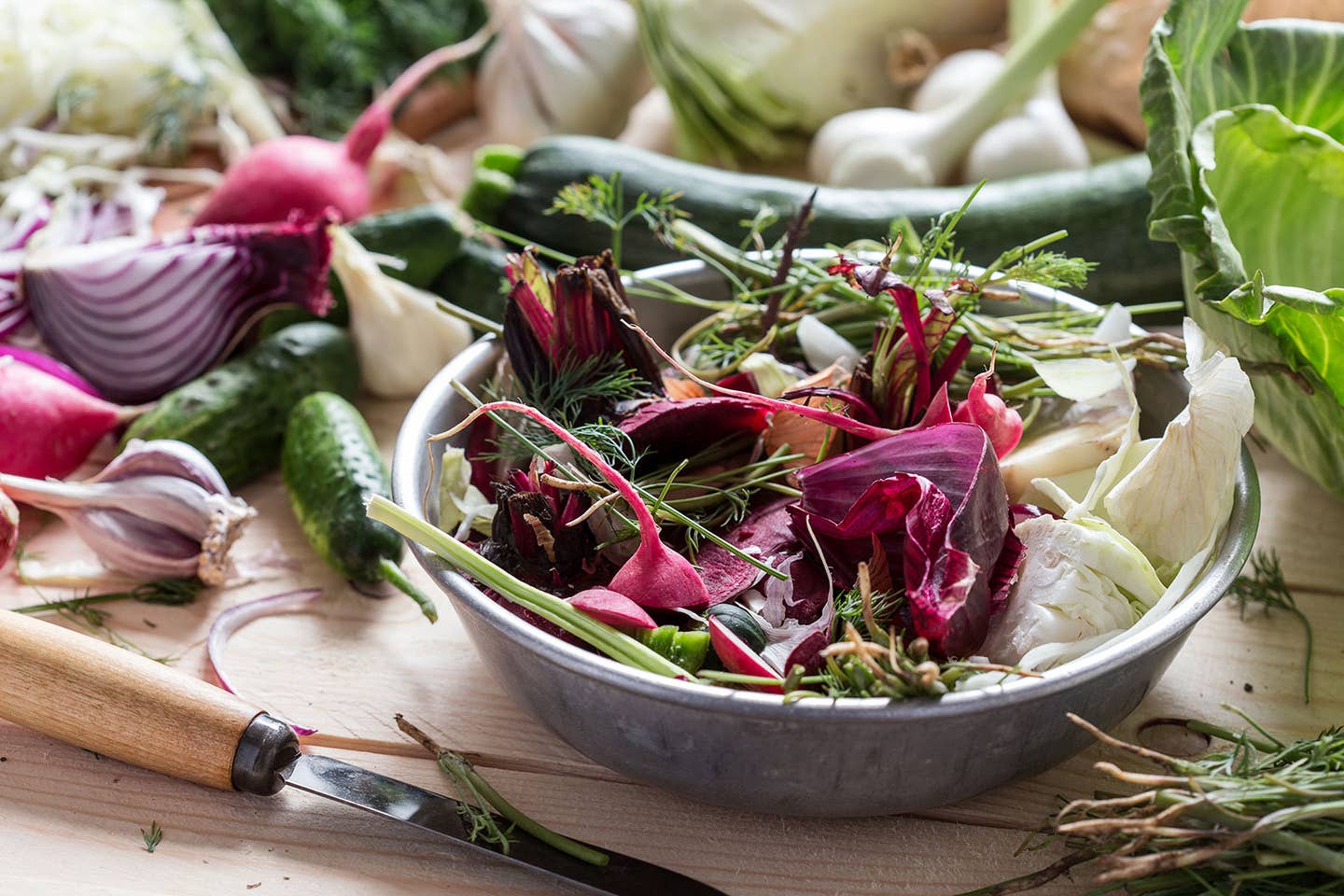
In the United States alone, nearly 400 pounds of food per person goes uneaten every year, and 21 percent of the space in our landfills is taken up by food waste. This is why it’s important to do our part: The surprisingly simple practice of composting can drastically impact those numbers, in addition to helping to reduce carbon dioxide and methane emissions.
Isabel Gunther, chef, and founder of Little Green Gourmets in NYC, is a big fan of at-home composting thanks to its sustainability. “For me personally, there’s satisfaction in not creating a lot of garbage and finding the designated place for it to go,” says Gunther. “I eat a lot of organics, and I feel I’m giving back by composting these nice things rather than contributing to the landfill.”
Emily Bachman, assistant director of GrowNYC Zero Waste Programs, agrees. “It’s shocking how much of our waste is actually compostable,” she notes. And not only does composting help fight climate change by reducing CO2 and methane emissions—on a microscale, it can also make for a cleaner kitchen. “When you separate out the food scraps and keep them in the freezer or refrigerator, it’s amazing how much better the kitchen smells and how much less frequently you need to take out the trash,” she adds.
We tapped sustainability experts, chefs, and authors for their advice on the best compost bins around, as well as best practices for composting in urban kitchens, creative reuse ideas, and ways to store your organic scraps in between trips to the green market.
- Best Overall: EPICA Stainless Steel Bin with Charcoal Filters
- Best Value: Package Free Compost Bin Container
- Best Design: Bamboozle Kitchen Composter
- Best Freezer-Friendly: Full Circle Food Scrap Collector and Freezer Compost Bin
- Best All-in-One: Vitamix FoodCycler
- Best for Bulkier Food Scraps: Brabantia Food Waste Caddy
- Best DIY: Yogurt containers
Features to Keep in Mind
Bin Size
A one-gallon bin is a great start for most—especially those with a small kitchen or without a backyard area. Since you want to dump your compost regularly to reduce icky smells or fruit flies around the house, store your food scraps in the fridge in between trips to the green market.
Design
Many bins come with a charcoal filter that is both reusable and washable. The filter reduces unwanted odors, fits right into the lid, and lasts between three to six months before it needs replacing.
Portability
If you opt to take your compost bin to a green market or another drop-off site, opt for a lightweight model (preferably with a handle). Otherwise, a sturdy, recyclable bag is perfectly fine for both transport and compost.
Storage
Sustainability experts and chefs unanimously agree that the freezer is the best place to store your organic scraps in between trips to the green market or compost site. “Whatever the container, for those of us without the luxury of a backyard compost bin steps from the home, I can’t recommend the freezer enough,” says Bachman. And any recyclable material can be used to store food scraps in the freezer; just be mindful of takeout boxes with a waxy seal and coffee cups with plastic liners, as many are not truly biodegradable.
Our Top Picks
Best Overall: EPICA Stainless Steel Bin with Charcoal Filters
Best Overall
Gunther says you don’t need anything fancy to begin this sustainable practice at home. “I’m very lo-fi, so I really like the classic stainless steel models,” she says. “I store mine in the freezer, and the charcoal filter is key. It really helps so it’s not smelly, and it’s quite effective. Plus they’re eco-friendly because you can wash them out with soap and water,” she adds. “I don’t personally have space to do a full-on processor at home, so I bring it to a municipal composter.”
But if you can’t make regular trips to the green market or your local food scrap drop-off location, Gunther points out there are curbside composting services that provide 5-gallon buckets and sawdust (to reduce the smell), like this one run by the NYC Sanitation Department. After being on hold during the pandemic, the sign-up service is back for fall 2021, but residents outside the metropolitan area should also check their local government websites or waste management companies for similar services.
Best Value: Package Free Compost Bin Container
Best Value
At under $20, the Package Free Compost Bin is not only low-cost but also compact and lightweight, making it a favorite for Natasha Berg, sustainability consultant and director of communications and partnerships at Oceanic Global, who keeps it counterside for easy access while cooking. “The Package Free compost bin is great because it’s the perfect size to sit right on my counter. It comes with cotton and an activated charcoal filter that keeps it odor-free without any chemical toxins or synthetic fragrances,” she adds. Plus it’s easy to take along on weekend trips,” she adds. Charcoal filter replacements start at $5, but they can be washed with soap and water several times and last up to six months. The filters are also compostable and help keep your compost fresher. “I take my whole bin to the drop-off site or sometimes transfer it in a compostable brown paper bag,” she adds.
Best Design: Bamboozle Kitchen Composter
Best Design
For eco-friendly aesthetes who don’t want to compromise their kitchen’s mise-en-place, Bamboozle’s countertop composter is a low-impact, high-design option. Made from biodegradable bamboo fiber with a breathable lid and carbon filter, the terra cotta option is a favorite of Miranda Bennett, founder of her namesake sustainable fashion brand. “It matches our Our Place Always Pan perfectly, not to mention our overall kitchen and household aesthetic,” she says. She also highlights Bamboozle’s reusable filters, which can be washed a few times before replacing. Her pro tip: “Do not skip a biodegradable liner!”
The Bamboozle is also the top pick for Elizabeth Van Lierde, author of Everyday Entertaining, who recommends the natural color version. "I once lived with a family for a summer during an internship that was big on composting,” she says. “The trick was to keep something light and easy on the eye so that it would live on the counter and would be easily accessible.”
Best Freezer-Friendly: Full Circle Food Scrap Collector and Freezer Compost Bin
Best Freezer-Friendly Bin
Since the freezer is clearly the best place to store your organic material, why not go for one specifically designed for it? Full Circle’s bin features a wire rim that attaches to kitchen drawers (so you can swipe away food bits right from your cutting board), and its flexible rectangular shape allows for easy storage right on your freezer rack. At $14 and with nearly five stars on Amazon, reviewers rave about how easy it is to empty and pop out food scraps when it’s time to compost. It’s dishwasher safe (top rack only), won’t attract flies (it’s stored in the freezer, after all), and works well with or without a liner. In between drop-offs, use biodegradable bags, produce bags, or brown paper bags to store your scraps until it’s ready to compost. The only drawback to this model? It’s made of silicon (aka plastic), so definitely consider this a long-term purchase.
Best All-in-One: Vitamix FoodCycler
Best All-in-One Bin + Composter
For those who don't live near a food scrap drop-off program, the Vitamix FoodCycler is a great all-in-one food recycler. It converts your food scraps into nutrient-rich fertilizer in four to eight hours and also doubles as a compost bucket with a carbon filter lid to help eliminate odors. You can store the 2L-capacity removable bucket under the sink, inside the freezer, or right on your countertop.
Berg also raves about the FoodCycler and uses the fertilizer to nourish her plants in her Brooklyn apartment. “I also normally keep my compost in the freezer until I can bring it to the farmer's market on the weekend, but with the Food Cycler, I can get my freezer space back and don't have to worry about missing a weekend drop-off every now and then,” she adds. Plus, cleanup is a breeze since the removable bucket is also dishwater safe. The drawback is that the machine uses electricity and takes up one cubic foot of counter space, so it’s not the best option for tiny kitchens.
Best for Bulkier Food Scraps: Brabantia Food Waste Caddy
Best for Bulkier Food Scraps
If you produce a lot of organic waste during the week, a small countertop bin may not do the trick. The Brabantia Food Waste Caddy comes in a variety of sizes, spanning 0.8 gallons to 4.2 gallons, and it can be either mounted on the wall or set alongside your regular waste bin. It features a handle to help with portability, and the removable lid holds the liner securely in place. We’re loving the multiple-size options for space flexibility, but we’re especially enamored with the mint green color of this model.
Best DIY: Yogurt Containers
Bachman is a big advocate of using an eco-friendly, biodegradable storage option you have on hand, emphasizing that people don’t have to buy anything in order to compost. “We see all kinds of methods for storing and transporting food scraps to our drop-off sites, from stainless steel bins with carbon filters to filthy old plastic bags,” she says. Her creative favorites include yogurt containers, milk cartons, plastic newspaper sleeves, and even hollowed-out watermelons. Since reducing our collective carbon footprint also means being mindful of new purchases, Bachman champions zero waste, which means “reducing consumption first, followed by repair, reuse, and ultimately recycling,” she adds. “If our efforts to increase recycling require increasing consumption, we’re missing the point.” Visit the New York City Department of Sanitation's guide to learn more about making your own compost.
Ask the Experts
Q: What food scraps cannot be composted?
Most organic waste can be composted, but it’s best to check with your municipal services and local green market first. Some programs do not accept animal bones, animal products, and meat scraps, for instance. Gunther points out that mollusk shells are sometimes turned away at compost sites (since they take so long to break down), as well as disposable paper products that contain a moisture barrier, like brown takeout boxes. Berg highlights a few other no-nos: namely “fats, oils, citrus peels, pet waste, charcoal ash, plastic labels on produce, coffee filters and tea bags made of synthetics, and yard waste with chemical pesticides.”
Q: Do I really need to use a compost bin liner?
Not necessarily, but it does make a big difference in the cleanup. For a stainless steel pail, Gunther recommends using a small section of a brown paper bag, paper towel, or any untreated, uncoated paper as a liner, as well as recyclable plastic bags.
Q: How often should I clean my compost bin?
For best results, every time you dump it, you should clean it. Soap and water usually do the trick, and some bins are also dishwasher safe. “You want to move the compostables regularly, too. You don’t want to have them in your house for two weeks,” says Gunther.
Our Take
If regularly recycling your food scraps feels like a big commitment, you can always start small and go from there. Coffee grinds, for instance, can make a big difference in the long run. “Certain things are easier to compost than others. If it feels cumbersome or prohibitive, you can pick the things that are less repulsive to compost, like coffee grinds. They don’t deteriorate the way fruit peels would, so when you start to collect them, [you’ll notice] it’s minimal smell and minimal effort—but it’s making a pretty big impact.” Not only will you be making a big difference in reducing landfill waste, but you’ll always learn more about your own consumption patterns (and feel pretty good about it in the process).
Keep Reading
Continue to Next Story
